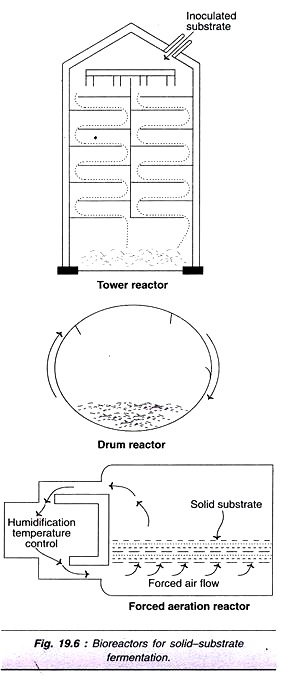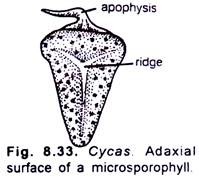ADVERTISEMENTS:
In this article we will discuss about:- 1. Introduction to Erysiphe 2. Primary Infection Caused by Erysiphe 3. Cell Structure 4. Haustorium 5. Disease Aspect.
Contents:
- Introduction to Erysiphe
- Primary Infection Caused by Erysiphe
- Cell Structure of Erysiphe
- Haustorium of Erysiphe
- Disease Aspect of Erysiphe
1. Introduction to Erysiphe:
ADVERTISEMENTS:
The type genus Erysiphe includes several species of which about 22 species are reported from India. All of them are obligate ectophytic parasites which infect a large number of species of angiosperms particularly the grains (cereals) and grass throughout the world. They occur on the aerial 1parts causing powdery mildew disease. These powdery mildew fungi are generally epidermal cell penetrating parasites.
The commonest species among these are:
1. E. cichoracearum:
It is the causal agent of powdery mildew disease of cucurbit.
ADVERTISEMENTS:
2. E. polygoni:
It causes powdery mildew of peas, areas on the infected leaf surface.
3. E. graminis:
It causes powdery mildew or cereal crops such as wheat, barley, rye, oats and also many of the grasses. It is the only species which causes powdery mildew on a monocotyledonous host. The powdery mildew disease of barley (Hordeum vulgare) and wheat are caused by E. graminis. f. sp. hordei and E. graminis f. sp. tritici respectively.
According to Yarwood (1957), many species of powdery mildews do not form cleistothecia in warm climates. They perpetuate themselves by means of conidia. The latter germinate immediately on falling on a suitable host. They are not long lived.
2. Primary Infection Caused by Erysiphe:
The conidium on falling on a suitable host (leaf) germinates immediately by putting out one to three germ tubes. The germ tube, soon after emergence bends down, comes in contact with the cuticle and widens to form an appressorium with a small lobe in the centre.
A fine tube-like outgrowth, the infection peg arises from the appressorial lobe, penetrates cuticle as well as the epidermal cell wall and grows into the lumen of the epidermal cell where a haustorium develops.
ADVERTISEMENTS:
A collar of amorphous material deposits around the penetration or infection peg. After the formation of the functional haustorium in the host epidermal cell, an elongating secondary hypha develops from the appressorium. The development of the secondary hypha is dependent on the formation of a functional haustorium in the host epidermal cell. It is a critical step in primary infection.
Haustorium is the only structure of the fungal parasite which develops inside the host. It has been reported that for every functional secondary hypha there is a corresponding haustorium in the leaf epidermis.
The secondary hypha, at the expense of the food material derived from the host plant, through the intracellular haustorium grows rapidly over the surface of the affected part (leaf or stem) of the host and branches rapidly to form the mycelium.
ADVERTISEMENTS:
ADVERTISEMENTS:
3. Cell Structure of Erysiphe:
The hyphal segments or cells are short. The cell wall is tripartite. There is the outer opaque wall layer and the third wall layer with a fine granular texture adjacent to the plasma membrane which shows slight undulations. The cell walls of the superficial hyphae are bounded by cuticle which connects the hyphae.
Each cell contains a single nucleus usually centrally located with a single nucleolus. The nuclear membrane has pores. The nucleus is embedded in a vacuolate cytoplasm containing glycogen as food reserve. Besides, embedded in the cytoplasm are the mitochondria, ER and microbodies.
ADVERTISEMENTS:
ADVERTISEMENTS:
4. Haustorium of Erysiphe:
Each hyphal colony which is the product of a single elongated secondary hypha has a single haustorium. All interactions between the parasite and the host occur through this region (haustorium). It lies in the lumen of the epidermal cell surrounded by the host cell protoplast. The haustorium may be simple and globular or pyriform in shape as in E. cichoracearum. In E. graminis it is more complex.
Fine Structure of the Haustorium of E. Graminis (Fig. 11.3):
ADVERTISEMENTS:
It has been studied by Bracker (1968) and later by Sullivan et al. (1974). The haustorium consists of a small, slender, tube-like hypha called the haustorial neck or stalk ending in an elongated, swollen plate like central structure known as the haustorial body.
The latter bears finger-like bodies (digitate processes) at either end and lies in the vacuole region of host cell almost filling it. The haustorial neck passes through the site of penetration in the outer wall of the host epidermal cell and connects the haustorial body to parent surface hyphae.
The stalk is constricted as it passes through the host cell wall. There is septum with a central pore at the distal end of the neck separating from the haustorial body. The septal pore may be open or plugged. When open it provides protoplasmic continuity between the two regions of the haustorium.
According to Bracker (1968) a collar like structure made up of the same material as the host cell wall surrounds the haustorial neck at its proximal end leaving a narrow channel-like space between the two. This collar is continuous with the host cell wall.
The wall and the plasma membrane of the surface hypha are continuous along the entire length of both the neck and the body regions of the haustorium constituting the haustorial wall and the haustorial membrane respectively.
Bracker reported that the protoplast of the neck or stalk region lacks the cell organelles whereas that of the haustorial body possesses mitochondria with plate-like cristae ,endoplasmic reticulum and a single nucleus but lacks the golgi apparatus.
ADVERTISEMENTS:
An electron dense matrix of finely granular amorphous material up to 5 µ surrounds the outer face of the body region of the haustorium and extends around the finger-like haustorial lobes. This sheath-like matrix is called the sheath matrix or extra haustorial matrix.
It is absent in the neck region. A thin membranous covering known as the sheath membrane or extra haustorial membrane (sometimes referred to as encapsulation membrane) delimits the sheath matrix from the host cytoplasm and thus forms the interface between the two.
The sheath membrane is considered a derivation of the host plasma membrane. This view is based on the hypothesis that the host plasma membrane is invaginated by the penetrating haustorium. The haustorium thus lies outside the host cytoplasm.
It is surrounded by a thin layer of host cytoplasm covered by the tonoplast on the side facing the central vacuole and by a sheath membrane (invaginated host plasma membrane) on the side facing the haustorium.
ADVERTISEMENTS:
The sheath matrix forms the physical boundary and the sheath membrane the key to the physical relationship between the host and the obligate fungal parasite. All interactions between the host and the parasite occur through this region.
5. Disease Aspect of Erysiphe:
Erysiphe is the causal agent of powdery mildew disease. The disease does not kill the host plant but it is reduced in vigour owing to constant loss of food. There is reduced yield and reduction in normal plumpiness of the Kernel.
Symptoms:
The disease appears on the aerial parts of the plant as white mildewy patches. At a later stage cleistothecia are visible as black specks over the white mycelial felt.
Host-Parasite Relationship:
Baenziger and Kilpatrick (1979) reported that yield losses caused by powdery mildew of wheat (Triticium aestivum) can be as high as 45 percent. This is attributed to the decrease in the photosynthetic activity of the leaf tissue as a result of the death of the mesophyll cells adjacent to the epidermal cells containing functional haustoria.
Last (1962) reported that the infected barley plants showed reduced yield, grain size and number of tillers. The root growth was reduced more than shoot growth. These harmful effects are attributed to increased respiration and decreased photosynthetic activity which result in deprivation to host of necessary metabolites for normal growth.
Overwintering:
According to many workers, overwintering takes place in the cleistothecial stage. Mundkar (1949) reported that the disease perpetuates through the dormant mycelium. According to Walker (1969), the parasite overwinters as a mycelial mat. The cleistothecia appear to him of secondary importance in overwintering.
There is evidence to show that the mycelium in some species of powdery mildews may overwinter in the dormant buds of perennial host plants. Yarwood (1957) is of the opinion that in warm climates the powdery mildews do not form cleistothecia. They perpetuate themselves by means of conidia. This view appears to be more plausible.
Control Measures:
Sowing resistant varieties of crop plants provides the best control of the disease. Rogueing of the diseased plants and burning them in the field is important. Dusting the crop with sulphur dust or spraying with karathane is effective in controlling the disease.
Powers (1958) reported that the antibiotic Anisomycin is effective to eradicate powdery mildew disease on wheat leaves. It is effective primarily by direct contact in the form of sprays.




